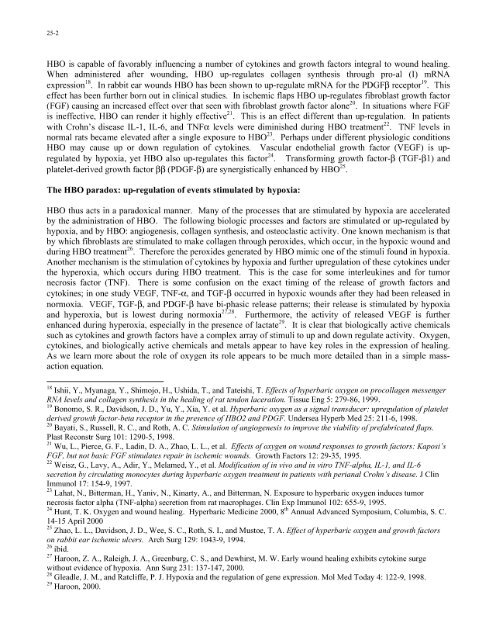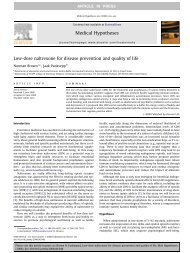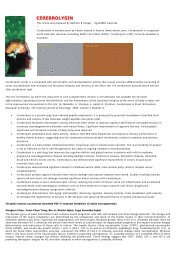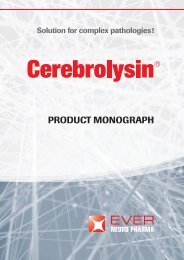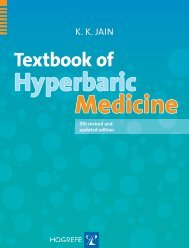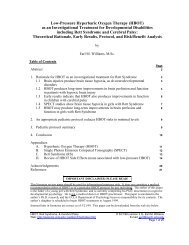The Relevance of Hyperbaric Oxygen to Combat Medicine
The Relevance of Hyperbaric Oxygen to Combat Medicine
The Relevance of Hyperbaric Oxygen to Combat Medicine
You also want an ePaper? Increase the reach of your titles
YUMPU automatically turns print PDFs into web optimized ePapers that Google loves.
25-2HBO is capable <strong>of</strong> favorably influencing a number <strong>of</strong> cy<strong>to</strong>kines and growth fac<strong>to</strong>rs integral <strong>to</strong> wound healing.When administered after wounding, HBO up-regulates collagen synthesis through pro-al (I) mRNAexpression 1 8 . In rabbit ear wounds HBO has been shown <strong>to</strong> up-regulate mRNA for the PDGFP3 recep<strong>to</strong>r 1 9 . Thiseffect has been further born out in clinical studies. In ischemic flaps HBO up-regulates fibroblast growth fac<strong>to</strong>r(FGF) causing an increased effect over that seen with fibroblast growth fac<strong>to</strong>r alone 20 . In situations where FGFis ineffective, HBO can render it highly effective 21 . This is an effect different than up-regulation. In patientswith Crohn's disease IL-1, IL-6, and TNFx. levels were diminished during HBO treatment22. TNF levels innormal rats became elevated after a single exposure <strong>to</strong> HB0 23 . Perhaps under different physiologic conditionsHBO may cause up or down regulation <strong>of</strong> cy<strong>to</strong>kines. Vascular endothelial growth fac<strong>to</strong>r (VEGF) is upregulatedby hypoxia, yet HBO also up-regulates this fac<strong>to</strong>r 24 . Transforming growth fac<strong>to</strong>r-P3 (TGF-P31) andplatelet-derived growth fac<strong>to</strong>r PP3 (PDGF-P3) are synergistically enhanced by HB0 25 .<strong>The</strong> HBO paradox: up-regulation <strong>of</strong> events stimulated by hypoxia:HBO thus acts in a paradoxical manner. Many <strong>of</strong> the processes that are stimulated by hypoxia are acceleratedby the administration <strong>of</strong> HBO. <strong>The</strong> following biologic processes and fac<strong>to</strong>rs are stimulated or up-regulated byhypoxia, and by HBO: angiogenesis, collagen synthesis, and osteoclastic activity. One known mechanism is thatby which fibroblasts are stimulated <strong>to</strong> make collagen through peroxides, which occur, in the hypoxic wound andduring HBO treatment 26 . <strong>The</strong>refore the peroxides generated by HBO mimic one <strong>of</strong> the stimuli found in hypoxia.Another mechanism is the stimulation <strong>of</strong> cy<strong>to</strong>kines by hypoxia and further upregulation <strong>of</strong> these cy<strong>to</strong>kines underthe hyperoxia, which occurs during HBO treatment. This is the case for some interleukines and for tumornecrosis fac<strong>to</strong>r (TNF). <strong>The</strong>re is some confusion on the exact timing <strong>of</strong> the release <strong>of</strong> growth fac<strong>to</strong>rs andcy<strong>to</strong>kines; in one study VEGF, TNF-u., and TGF-P3 occurred in hypoxic wounds after they had been released innormoxia. VEGF, TGF-P3, and PDGF-P3 have bi-phasic release patterns; their release is stimulated by hypoxiaand hyperoxia, but is lowest during normoxia27,28. Furthermore, the activity <strong>of</strong> released VEGF is further29enhanced during hyperoxia, especially in the presence <strong>of</strong> lactate . It is clear that biologically active chemicalssuch as cy<strong>to</strong>kines and growth fac<strong>to</strong>rs have a complex array <strong>of</strong> stimuli <strong>to</strong> up and down regulate activity. <strong>Oxygen</strong>,cy<strong>to</strong>kines, and biologically active chemicals and metals appear <strong>to</strong> have key roles in the expression <strong>of</strong> healing.As we learn more about the role <strong>of</strong> oxygen its role appears <strong>to</strong> be much more detailed than in a simple massactionequation."18 Ishii, Y., Myanaga, Y., Shimojo, H., Ushida, T., and Tateishi, T. Effects <strong>of</strong> hyperbaric oxygen on procollagen messengerRNA levels and collagen synthesis in the healing <strong>of</strong> rat tendon laceration. Tissue Eng 5: 279-86, 1999.19 Bonomo, S. R., Davidson, J. D., Yu, Y., Xia, Y. et al. <strong>Hyperbaric</strong> oxygen as a signal transducer: upregulation <strong>of</strong>plateletderived growth fac<strong>to</strong>r-beta recep<strong>to</strong>r in the presence <strong>of</strong> HB02 and PDGF. Undersea Hyperb Med 25: 211-6, 1998.20 Bayati, S., Russell, R. C., and Roth, A. C. Stimulation <strong>of</strong> angiogenesis <strong>to</strong> improve the viability <strong>of</strong>prefabricated flaps.Plast Reconstr Surg 101: 1290-5, 1998.21 Wu, L., Pierce, G. F., Ladin, D. A., Zhao, L. L., et al. Effects <strong>of</strong> oxygen on wound responses <strong>to</strong> growth fac<strong>to</strong>rs: Kaposi'sFGF, but not basic FGF stimulates repair in ischemic wounds. Growth Fac<strong>to</strong>rs 12: 29-35, 1995.22 Weisz, G., Lavy, A., Adir, Y., Melamed, Y., et al. Modification <strong>of</strong> in vivo and in vitro TNF-alpha, IL-1, and IL-6secretion by circulating monocytes during hyperbaric oxygen treatment in patients with perianal Crohn's disease. J ClinImmunol 17: 154-9, 1997.23 Lahat, N., Bitterman, H., Yaniv, N., Kinarty, A., and Bitterman, N. Exposure <strong>to</strong> hyperbaric oxygen induces tumornecrosis fac<strong>to</strong>r alpha (TNF-alpha) secretion from rat macrophages. Clin Exp Immunol 102: 655-9, 1995.24 Hunt, T. K. <strong>Oxygen</strong> and wound healing. <strong>Hyperbaric</strong> <strong>Medicine</strong> 2000, 8th Annual Advanced Symposium, Columbia, S. C.14-15 April 200025 Zhao, L. L., Davidson, J. D., Wee, S. C., Roth, S. I., and Mus<strong>to</strong>e, T. A. Effect <strong>of</strong> hyperbaric oxygen and growth fac<strong>to</strong>rson rabbit ear ischemic ulcers. Arch Surg 129: 1043-9, 1994.26 ibid.27 Haroon, Z. A., Raleigh, J. A., Greenburg, C. S., and Dewhirst, M. W. Early wound healing exhibits cy<strong>to</strong>kine surgewithout evidence <strong>of</strong> hypoxia. Ann Surg 231: 137-147, 2000.28 Gleadle, J. M., and Ratcliffe, P. J. Hypoxia and the regulation <strong>of</strong> gene expression. Mol Med Today 4: 122-9, 1998.29 Haroon, 2000.


